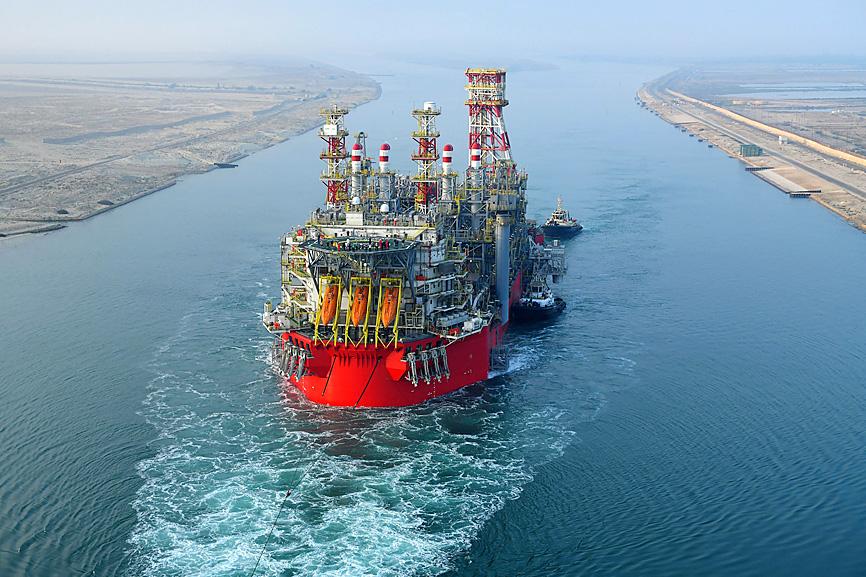Egypt’s Suez Canal Authority yesterday announced an all-time revenue record, earning US$7 billion during the past fiscal year following a series of toll hikes for vessels transiting the vital waterway.
Between July last year and last month — Egypt’s fiscal year — about 1.32 billion tonnes of cargo were shipped through the canal, Suez Canal Authority (SCA) head Osama Rabie said.
The income is more than one-fifth higher than the previous fiscal year’s US$5.8 billion in transit fees, and the highest figure ever recorded.

Photo: AFP
“Global crises have proven the importance of the Suez Canal to ensuring the sustainability of global supply chains,” Rabie said.
Connecting the Red Sea and the Mediterranean, the canal accounts for about 10 percent of global maritime trade.
It is also a source of much-needed foreign currency for Egypt, which is battling crippling inflation and a currency devaluation triggered by Russia’s invasion of Ukraine.
The SCA has hiked passage tolls for transiting vessels, including fuel tankers, twice this year.
In April, the waterway recorded its highest-ever monthly revenue of US$629 million, despite the rise in oil prices due to Russia’s invasion of Ukraine.
As Egypt reels under mounting economic pressures from the war, foreign currency reserves fell US$5.5 billion from March to May to stand at US$35.5 billion.
Soaring world commodity prices helped push Egyptian inflation to a three-year high of 15.3 percent last month, according to official figures.
In late March, the Central Bank of Egypt allowed the Egyptian pound to depreciate against the US dollar, causing it to lose about 18 percent of its value overnight.
Cairo has been rushing to mitigate the economic fallout, requesting a new loan from the IMF, and rallying billions of dollars’ worth of investment from Saudi Arabia and Qatar.
Last week, Egypt announced that it is to receive US$500 million from the World Bank.
Earlier this year, the SCA reported the canal’s highest annual revenue for a calendar year, netting US$6.3 billion last year, despite the COVID-19 pandemic and a six-day blockage by giant cargo ship the Ever Given.

WEAKER ACTIVITY: The sharpest deterioration was seen in the electronics and optical components sector, with the production index falling 13.2 points to 44.5 Taiwan’s manufacturing sector last month contracted for a second consecutive month, with the purchasing managers’ index (PMI) slipping to 48, reflecting ongoing caution over trade uncertainties, the Chung-Hua Institution for Economic Research (CIER, 中華經濟研究院) said yesterday. The decline reflects growing caution among companies amid uncertainty surrounding US tariffs, semiconductor duties and automotive import levies, and it is also likely linked to fading front-loading activity, CIER president Lien Hsien-ming (連賢明) said. “Some clients have started shifting orders to Southeast Asian countries where tariff regimes are already clear,” Lien told a news conference. Firms across the supply chain are also lowering stock levels to mitigate

Six Taiwanese companies, including contract chipmaker Taiwan Semiconductor Manufacturing Co (TSMC, 台積電), made the 2025 Fortune Global 500 list of the world’s largest firms by revenue. In a report published by New York-based Fortune magazine on Tuesday, Hon Hai Precision Industry Co (鴻海精密), also known as Foxconn Technology Group (富士康科技集團), ranked highest among Taiwanese firms, placing 28th with revenue of US$213.69 billion. Up 60 spots from last year, TSMC rose to No. 126 with US$90.16 billion in revenue, followed by Quanta Computer Inc (廣達) at 348th, Pegatron Corp (和碩) at 461st, CPC Corp, Taiwan (台灣中油) at 494th and Wistron Corp (緯創) at

NEGOTIATIONS: Semiconductors play an outsized role in Taiwan’s industrial and economic development and are a major driver of the Taiwan-US trade imbalance With US President Donald Trump threatening to impose tariffs on semiconductors, Taiwan is expected to face a significant challenge, as information and communications technology (ICT) products account for more than 70 percent of its exports to the US, Chung-Hua Institution for Economic Research (CIER, 中華經濟研究院) president Lien Hsien-ming (連賢明) said on Friday. Compared with other countries, semiconductors play a disproportionately large role in Taiwan’s industrial and economic development, Lien said. As the sixth-largest contributor to the US trade deficit, Taiwan recorded a US$73.9 billion trade surplus with the US last year — up from US$47.8 billion in 2023 — driven by strong

ASE Technology Holding Co (ASE, 日月光投控), the world’s biggest chip assembly and testing service provider, yesterday said it would boost equipment capital expenditure by up to 16 percent for this year to cope with strong customer demand for artificial intelligence (AI) applications. Aside from AI, a growing demand for semiconductors used in the automotive and industrial sectors is to drive ASE’s capacity next year, the Kaohsiung-based company said. “We do see the disparity between AI and other general sectors, and that pretty much aligns the scenario in the first half of this year,” ASE chief operating officer Tien Wu (吳田玉) told an